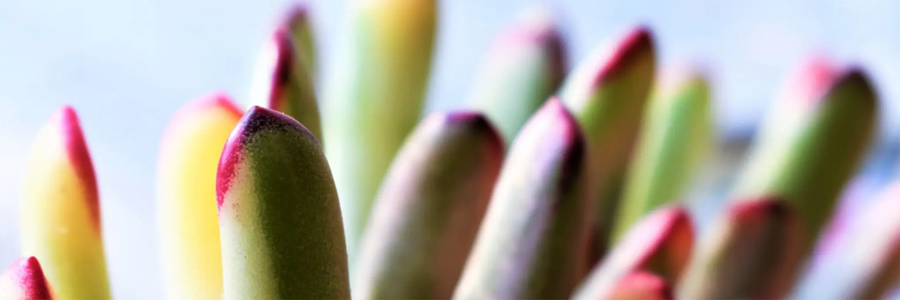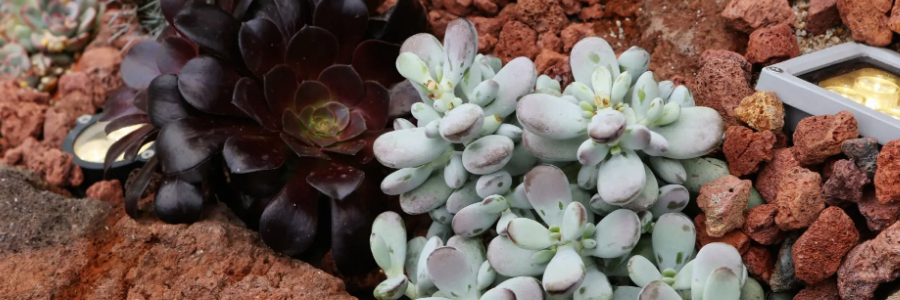Cotyledon
Taxonomic Classification
The Cotyledon genus belongs to the family Crassulaceae. It encompasses around 20 species of succulent plants. The name “Cotyledon” is derived from the Greek word “kotyledon”, which means cup – shaped, likely referring to the shape of the seed leaves in some of its species. Native to southern Africa, these plants have adapted to a variety of arid and semi – arid habitats, from rocky outcrops to dry slopes.
Morphological Characteristics
1.Leaf Structure
Cotyledon plants are characterized by their thick, fleshy leaves. The leaves can vary in shape, with some species having round, oval, or even elongated and pointed leaves. For example, Cotyledon orbiculata has thick, rounded leaves that are often green with a red or purple tinge around the edges, especially when exposed to stress factors such as strong sunlight or temperature changes. The leaves are typically arranged in a rosette pattern at the end of short stems, creating an attractive and symmetrical appearance. Some species may have a powdery or waxy coating on the leaves, which helps to protect them from excessive sunlight and water loss.
2.Stem and Growth Habit
The stems of Cotyledon can be either short and stout, as in Cotyledon tomentosa (Bear’s Paw), or more elongated and branching, like in Cotyledon macrantha. Some species may develop a somewhat woody stem as they mature. As the plants grow, they may produce offsets, which are small plantlets that emerge from the base of the mother plant. These offsets can be easily separated and propagated, contributing to the spread of the plant. Some Cotyledon species may also produce long, thin flower stalks that rise above the rosettes.
3.Flowering Characteristics
When Cotyledon plants flower, they produce clusters of small, bell – shaped or tubular flowers. The flowers are usually borne on long, arching stalks that emerge from the center of the rosette. The petals of the flowers can be white, yellow, orange, or pink, depending on the species. The flowers have a delicate appearance and are often arranged in a loose, branched inflorescence. The flowering period usually occurs in spring or summer, but it can vary slightly depending on the species and the local climate.
Common Varieties
1.Cotyledon orbiculata
Also known as Pig’s Ear, Cotyledon orbiculata has thick, rounded leaves that are usually green with a red or purple margin when exposed to bright light. The leaves are arranged in a loose rosette. This species can grow up to 1 – 2 meters tall and produces clusters of small, orange – red, bell – shaped flowers on long stalks in spring or summer. It is a relatively easy – to – care – for plant and is popular in succulent gardens and as a potted plant.
2.Cotyledon tomentosa
Bear’s Paw, Cotyledon tomentosa, has unique, furry – looking leaves. The leaves are thick, oval – shaped, and covered in small, white hairs. At the tips of the leaves, there are small, dark – colored “claws”, which give the plant its common name. It forms small rosettes and produces small, white or pale pink flowers on long stalks in spring. It is a slow – growing species but is highly prized for its cute and distinctive appearance.
3.Cotyledon macrantha
This variety has elongated, lance – shaped leaves that are arranged in a rosette. The leaves are green and may develop a red tinge at the edges when stressed. Cotyledon macrantha can grow relatively tall and produces large, tubular, orange – red flowers on long, arching stalks. It is a showy plant that is suitable for both indoor and outdoor cultivation in suitable climates.
4.Cotyledon pendens
Cotyledon pendens has long, narrow, pendulous leaves that are green with a hint of red or purple. The leaves are arranged in a rosette at the end of long, thin stems, giving the plant a trailing growth habit. It produces small, bell – shaped, yellow flowers on long stalks. It is often grown in hanging baskets or as a trailing element in succulent arrangements.
5.Cotyledon ladismithiensis
This species has thick, oval – shaped leaves that are covered in a powdery substance, giving them a gray – green appearance. The leaves are arranged in a tight rosette. Cotyledon ladismithiensis produces small, yellow – orange flowers on long stalks in spring or summer. It is a unique – looking plant that is sought – after by succulent collectors.


